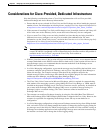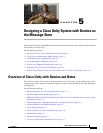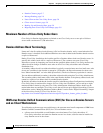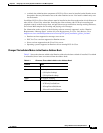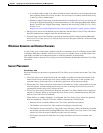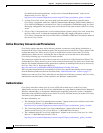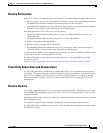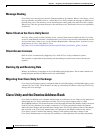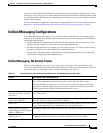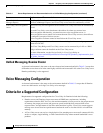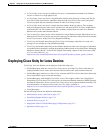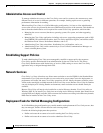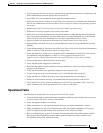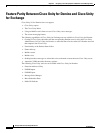
5-7
Design Guide for Cisco Unity Release 5.x
OL-14619-01
Chapter 5 Designing a Cisco Unity System with Domino as the Message Store
Overview of Cisco Unity with Domino and Notes
Domino Permissions
Before Cisco Unity is installed, the Cisco Unity installer or a qualified Domino administrator needs to:
• Create a group for Cisco Unity servers named UnityServers, and grant the group Editor permissions
for Admin4.nsf and Editor with Delete Documents permissions for Names.nsf.
• Confirm that the UnityServers group has the permissions required to create databases and templates.
This allows Cisco
Unity to create mail files for the default accounts.
With these permissions, Cisco Unity acts as a Notes user to:
• Import data from the Domino address book to create Cisco Unity subscribers, contacts, and
distribution lists.
• Change the Domino address book by using the Cisco Unity Administrator.
• Submit voice messages through Domino.
• Retrieve and play messages left for subscribers.
• Get information about the read/unread status of voice messages, e-mail, and fax messages in a
subscriber mailbox, and send notification when there are new messages.
In addition, when a Domino user is imported into Cisco Unity, Cisco Unity submits an AdminP request
to grant the user access to the imported user mail file.
For more information on setting Domino-specific permissions, see the applicable Cisco Unity
installation guide, at
http://www.cisco.com/en/US/products/sw/voicesw/ps2237/prod_installation_guides_list.html.
Cisco Unity Subscribers and Domino Users
A Cisco Unity subscriber is a Domino user who has been DUC for Cisco-enabled and imported into
Cisco
Unity. The person document of each subscriber has Cisco Unity attributes, and the mail file has
DUC for Cisco attributes. The only way to create a Cisco
Unity subscriber is to import an existing
Domino user into Cisco
Unity. Cisco Unity cannot create Domino users by using the Cisco Unity
Administrator.
Domino Clusters
Cisco Unity supports homing Cisco Unity subscribers on Domino clusters. The Domino cluster must
meet all IBM Lotus requirements, particularly those related to the maximum number of users and to
supported hardware.
Depending on the number of users on a cluster, the customer may want to install one Cisco Unity server
for each Domino cluster.
The customer is responsible for installing, configuring, and maintaining the Domino cluster.
For more information on Domino clusters, refer to the Lotus Domino documentation, available on the
Lotus Domino website.



